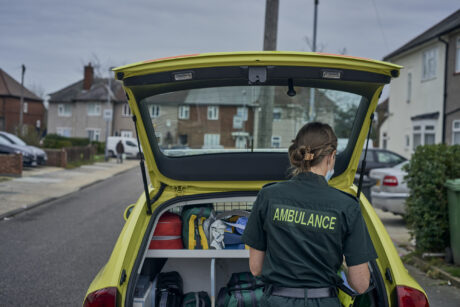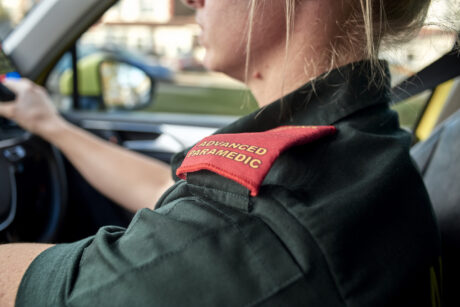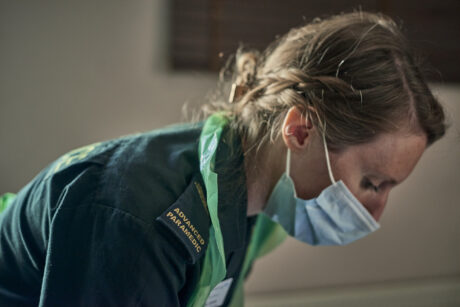Single responders
As well as crews who work together on an ambulance, we also have a number of single responders, who go to patients by car, motorcycle or bicycle.
They are able to treat patients without the help of an ambulance crew, or are sent to a patient ahead of an ambulance as they still carry the vital life-saving equipment needed in an emergency.
In life-threatening emergencies we will send a single responder and an ambulance crew to treat the patient. In these situations every second counts, and a single responder can get through the traffic faster than a large ambulance which means we can get treatment to a patient more quickly.
However, our single responders have been fully trained to work on their own. They are emergency medical technicians or paramedics who have the skills to assess patients to see whether they definitely need treatment by an ambulance crew.
Our Incident Response Officers (IROs) respond to and oversee complex incidents or situations involving multiple patients – and also support the welfare of our staff and volunteers on scene.
In some parts of London we are supported in our work by ambulance community responders, who work for us on a voluntary basis. These are members of the public who have had emergency life-support training, and they respond alongside our staff to life-threatening 999 calls.
We plan to increase the number of single responders to ensure that we are able to retain crewed ambulances for those patients who need them.
Click on the boxes to find out about all our different single responders:
-
Critical care advanced paramedic practitioners (APPs)
Our Advanced Paramedic Practitioners in Critical Care (APP-CC) treat the most seriously ill and injured patients – including patients in cardiac arrest and with serious traumatic injuries. They also attend complex maternity calls, or challenging cases where enhanced decision making or crew management is required.

They have additional post-graduate education and carry extra medicines and equipment.
The team are based out of Westminster, Croydon, Brent and Ilford Ambulance stations.
The APP-CC function allows for 24 hour a day cover and there will usually be around three to five APP-CCs on shift to respond across the entirety of the Service’s geographical area. There will also be one APP-CC in our Emergency Operations Centre (EOC).
The APP-CC in the EOC will monitor 999 calls to see where the skills of their fellow advanced paramedics could be required and will dispatch the APP-CCs who are in response cars to patients. They can also speak to callers to provide clinical advice and to learn more about the patient’s condition to make a judgement on whether an APP-CC should be dispatched.
-
Urgent care advanced paramedic practitioners (APPs)
Our Advanced Paramedic Practitioners in Urgent Care (APP-UC) respond to a variety of different calls for patients with a variety of illnesses and injuries.

They have an advanced level of clinical practice in terms of assessment, clinical decision making and diagnosis and have completed, or are working towards, a Master’s Degree in Advanced Practice. Their extra post-graduate education, skills and the medicines they carry mean they are able to treat more patients in their own homes, rather than in hospital where a trip to the emergency department can be avoided.
Our Advanced Paramedics in Urgent Care respond across the capital each day. There are usually five APP-UC working in our response cars, as well as one in our Emergency Operations Centre (EOC). Here, the APP-UC will monitor 999 calls to see where the skills of their fellow advanced paramedics could be required and will dispatch the APP-UCs who are in response cars to patients.
On scene, our APP-UCs conduct a thorough assessment of the patient’s condition and recommend the right treatment and diagnosis. They aim to treat and keep the patient home or within their community as much as possible.
They can also speak to callers to provide clinical advice and to learn more about the patient’s condition to make a judgement on whether an APP-UC should be dispatched. As well as this, they work closely with other healthcare providers in the capital, rotating across different clinical settings outside of the ambulance service, such as General Practice, Urgent Care Centres and Minor injury units. This means that the APP-UC is able to apply what they learn in one area to another, benefiting all the patients they see.
-
Cycle response unit
Our pedal powered paramedics can often be first on scene at a 999 call as they weave through (or cut out!) London traffic. Our cycle responders operate in busy locations, especially where there are large pedestrian areas including Canary Wharf, Croydon, Kensington, St Pancras Station and Heathrow Airport. Watch this video and join them on a ride out.
-
Motorcycle response unit
Meet our motorcycle response unit on a typical day responding to 999 calls in London.
-
Incident Response Officers
Our Incident Response Officers (IROs) respond to and oversee complex incidents or situations involving multiple patients – and also support the welfare of our staff and volunteers on scene.
There are usually eight IROs per shift, responding across the capital. IRO teams respond from eight bases across London and respond 24/7.

Follow us on social media: